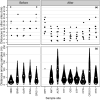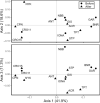Calm after the storm? Similar patterns of genetic variation in a riverine foundation species before and after severe disturbance
- PMID: 37920773
- PMCID: PMC10618894
- DOI: 10.1002/ece3.10670
Calm after the storm? Similar patterns of genetic variation in a riverine foundation species before and after severe disturbance
Abstract
In summer 2011, Tropical storms Lee and Irene caused an estimated 90% decline of the submersed aquatic plant Vallisneria americana Michx. (Hydrocharitaceae) in the Hudson River of New York (USA). To understand the genetic impact of such large-scale demographic losses, we compared diversity at 10 microsatellite loci in 135 samples collected from five sites just before the storms with 239 shoots collected from nine sites 4 years after. Although 80% of beds sampled in 2011 lacked V. americana in 2015, we found similar genotypic and genetic diversity and effective population sizes in pre-storm versus post-storm sites. These similarities suggest that despite local extirpations concentrated at the upstream end of the sampling area, V. americana was regionally resistant to genetic losses. Similar geographically based structure among sites in both sampling periods suggested that cryptic local refugia at previously occupied sites facilitated re-expansion after the storms. However, this apparent resistance to disturbance may lead to a false sense of security. Low effective population sizes and high clonality in both time periods suggest that V. americana beds were already small and had high frequency of asexual reproduction before the storms. Dispersal was not sufficient to recolonize more isolated sites that had been extirpated. Chronic low diversity and reliance on asexual reproduction for persistence can be risky when more frequent and intense storms are paired with ongoing anthropogenic stressors. Monitoring genetic diversity along with extent and abundance of V. americana will give a more complete picture of long-term potential for resilience.
Keywords: conservation genetics; disturbance effects; ecological disturbance; genetic bottleneck; genotypic diversity; resilience; submersed aquatic vegetation.
© 2023 The Authors. Ecology and Evolution published by John Wiley & Sons Ltd.
Conflict of interest statement
The authors declare we have no competing interests.
Figures







References
-
- Adamack, A. T. , & Gruber, B. (2014). PopGenReport: Simplifying basic population genetic analyses in R. Methods in Ecology and Evolution, 5, 384–387. 10.1111/2041-210X.12158 - DOI
-
- Alcoverro, T. , Manzanera, M. , & Romero, J. (2001). Annual metabolic carbon balance of the seagrass Posidonia oceanica: The importance of carbohydrate reserves. Marine Ecology Progress Series, 211, 105–116. 10.3354/meps211105 - DOI
-
- Alcoverro, T. , Zimmerman, R. C. , Kohrs, D. G. , & Alberte, R. S. (1999). Resource allocation and sucrose mobilization in light‐limited eelgrass Zostera marina . Marine Ecology Progress Series, 187, 121–131. 10.3354/meps187121 - DOI
Associated data
LinkOut - more resources
Full Text Sources

